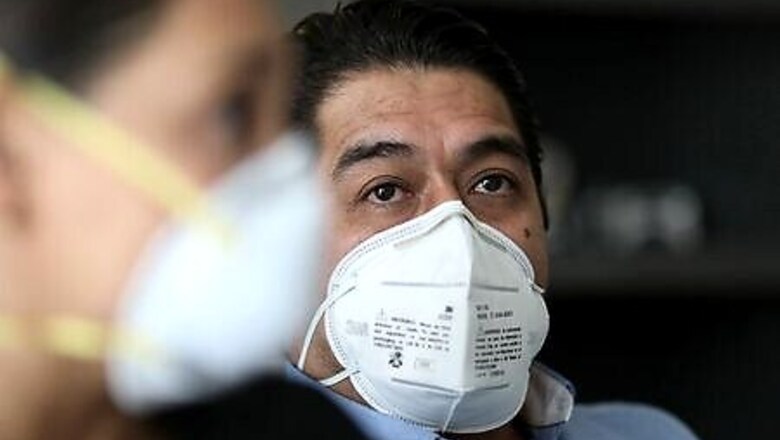
views
MEXICO CITY When the coronavirus epidemic began to intensify in Mexico at the end of March, Doctor Jose Garcia said his bosses at a public trauma hospital in Mexico City denied his request for masks, gloves and disinfectant.
They argued such protective equipment was only necessary for those working directly with coronavirus patients, Garcia said. Unconvinced, he bought it himself.
The hospital’s director disputes this, saying all staff received protective equipment. Either way, Garcia had already contracted the virus and infected his wife and one-year-old daughter.
Garcia is one of over 70,000 medical workers to catch the coronavirus in Mexico, where the pandemic death toll is now the third-highest worldwide, behind the United States and Brazil.
Government data indicates that healthcare workers’ risk of dying is four times higher than in the United States, and eight times higher than in Brazil.
“The coronavirus has hit healthworkers all over the world, but it’s been especially bad in Mexico,” said Alejandro Macias, an epidemiologist who spearheaded Mexico’s response to the 2009 swine flu pandemic.
Staff have had to buy their own equipment, often in informal marketplaces and of substandard quality, Macias said.
The government has said there were shortcomings in equipment provision early on but says it has worked hard to protect workers and flown in vital equipment from China and the United States. It also accuses past administrations of letting the health service deteriorate.
Mexico’s deputy health minister and coronavirus czar, Hugo Lopez-Gatell, said in July that many of the nurses and doctors who died of the virus had pre-existing medical conditions, and that some did not use protective gear in “optimal fashion.”
In Mexico, 19% of confirmed infections are of medical staff, almost three times the global average, according to figures from the International Council of Nurses and the Mexican National Association of Doctors and Nurses.
The plight of healthworkers is complicating efforts to contain the outbreak, which has killed close to 50,000 people in Mexico, battered the economy and cost millions of jobs.
Garcia, 48, said in an interview that he believes he was one of about a dozen medical staff indirectly infected by a patient who arrived at the Lomas Verdes hospital with coronavirus symptoms and later died.
“They’ve been very irresponsible with us,” he said, referring to his employer and its alleged failure to provide protective equipment.
The hospital’s director, Gilberto Meza, said that 213 Lomas Verdes staff had contracted the virus. Citing an epidemiological study he said the hospital had conducted, he said that all were infected outside the facility.
He said all staff had received goggles, face shields and masks. He declined to say when they were provided.
Garcia and his family survived and he is now back at work. But the two weeks they had coronavirus symptoms were, he said, “hell”: headaches, fever, diarrhea and shortness of breath.
As of July 24, 72,980 Mexican medical staff had caught the coronavirus, and 978 died, government figures show.
In the United States, which has a population 2.5 times that of Mexico, 123,738 medical personnel have tested positive for coronavirus and 598 have died, according to the most recent Centers for Disease Control and Prevention (CDC) figures.
The health ministry of Brazil, which is about two-thirds more populous than Mexico, had reported 189 deaths of medical practitioners by end-July. Some private data in Brazil give higher figures, but still well below Mexico.
Over a dozen nurses and doctors interviewed by Reuters said they got the virus in part because they did not receive timely information or protective equipment.
Many have protested about having to reuse disposable gear and launched petitions for better kit.
In one public hospital in northern Mexico, medical workers told Reuters in April their managers told them not to wear protective masks to avoid unsettling patients.
Zoe Robledo, head of Mexico’s main public health service, IMSS, said in April that it had suffered equipment shortages, as well as “delays, oversights, and errors that needed correcting.”
LOW SPENDING
Mexico’s spending on health as a share of gross domestic product (GDP) is one of the lowest in the 37-member Organisation for Economic Co-operation and Development (OECD).
A recent study by the OECD put Mexico’s health spending at 5.5% of GDP, compared to 9.1% in Chile and 7.3% in Colombia in 2019. In Brazil it was 9.4%, though the latest data available were from 2017.
Nurses often work in multiple hospitals to supplement wages of about 8,500 pesos ($377) per month, according to Mexico City’s government. Movement between hospitals heightens the contagion risk, said Oliva Lopez, the city’s health minister.
“Our health personnel combine multiple jobs and are exposed in multiple spaces,” Lopez told Reuters, saying her ministry had gone to great lengths to get staff protective equipment, and blaming previous governments for “pauperizing” the profession.
More than 600 nurses had died by the end of June in some 30 countries surveyed by the Geneva-based International Council of Nurses. Mexico accounted for 160 of the deaths, or over a quarter.
Speaking on condition of anonymity, one nurse at a Mexico City public hospital said she felt “abandoned” by authorities.
“But we can’t say: ‘Now I can’t work, or don’t want to’,” she said. “This is what we trained for.”
Disclaimer: This post has been auto-published from an agency feed without any modifications to the text and has not been reviewed by an editor



















Comments
0 comment